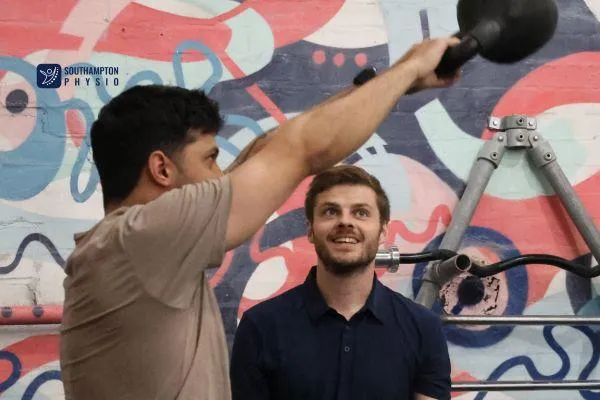
Fitness shouldn’t make you feel like you’re failing before you’ve started
Why So Many People Feel Shut Out of Fitness
You’ve probably seen the adverts: battle ropes, burpees, bodies dripping in sweat.
It’s the classic image of boot camp-style fitness. No pain, no gain. Go hard or go home.
But for many people - especially those living with persistent pain, fatigue or an unpredictable body - these formats don’t just miss the mark. They make you feel like the problem.
You try to keep up, but your joints flare. You feel awkward modifying every movement. You’re praised for pushing harder when you know what your body needs is to slow down.
And when it doesn’t work out? You’re left thinking it must be your fault.
It’s not.
This isn’t about willpower. It’s about a system that wasn’t built for you in the first place.
A Fitness Model Built for the Few
The origins of mainstream group fitness lie in military training and athletic performance.
That legacy is still everywhere: boot camp classes, instructor-led drills and an emphasis on intensity and discipline. Even many PTs still use cookie-cutter circuits borrowed from sports science or bodybuilding.
These methods have their place. They work brilliantly for some. But they’re built around a particular kind of person:
Already fit
Relatively injury-free
With predictable energy and pain levels
Motivated by challenge, novelty or competition
They weren’t designed for:
Someone recovering from back pain or surgery
A woman navigating perimenopause and unpredictable fatigue
A person with hypermobility who needs joint control, not chaos
Anyone who doesn’t want to be yelled at to "dig deeper"
Yet these formats have become the default - even when they clearly don’t serve most of the population.
What the Research Shows Us
The research into exercise adherence and motivation paints a clear picture. People stick with movement when they feel seen, supported and in control.
Studies show that emotionally safe, inclusive environments lead to better enjoyment and consistency. When people understand the "why" behind what they’re doing and feel they can work at a pace that suits their body’s reality, they’re more likely to keep going.
Moderate, steady progress tends to work better than high-intensity blasts for those managing fatigue, pain or long-term conditions. And most importantly, when people feel judged or incompetent, they disengage. That sense of "I’m always behind" or "I can’t do it right" is one of the biggest predictors of dropping out.
None of this means we can’t work hard or progress. But it has to happen in the right setting, at the right time and with the right kind of support.
When Fitness Leaves People Behind
Let’s name what our patients have told us time and again:
“I felt like I was the only one struggling.”
“They didn’t understand why I couldn’t push through.”
“It felt like everyone else had a normal body but me.”
“I kept injuring myself trying to keep up.”
“They said to listen to my body, but then acted like I was lazy if I slowed down.”
The common thread? These people didn’t fail. They were failed by an approach that doesn’t flex.
You and Me Both
And I get it. Because I’ve lived it too.
For years, I threw myself into fitness with a mix of enthusiasm, joy - and if I’m honest, a bit of shame. I wanted to be the kind of person who could keep up. Who could push through. Who didn’t have to think twice.
But living with chronic fatigue and persistent pain made that feel impossible.
I’d try something new - martial arts, group training, whatever was on offer - and I’d go all in. Not because I didn’t know better. But because holding back felt like giving up.
I always hoped this time would be different.
But I couldn’t ignore the post-exertional crashes. The days of exhaustion that followed. The flare-ups of neck pain that made basic things like driving or working feel ten times harder.
Eventually, I had to stop doing martial arts altogether. That "leave everything on the mat" mindset might work for some - but it left me wiped out, flared up and frustrated.
It took me a long time to realise the problem wasn’t me.
It was the format. The pressure. The invisible rules I felt I had to follow to be seen as someone who belonged.
That’s why I built something different.
What Actually Helps People Succeed
So if intensity-first fitness isn’t the answer for most people… what is?
The evidence points to a different model:
Personalisation. Programmes must account for injury history, energy levels, confidence and real-life stressors.
Progressive overload - but with nuance. People get stronger through challenge, yes - but only when it’s tolerable, titrated and sustainable.
Education and empowerment. Knowing why an exercise matters and how to adjust it makes people feel competent and in control.
Supportive settings. Environments that ditch judgement, comparison or performative toughness foster genuine progress.
Clinically-informed coaching. When movement professionals understand fatigue, pain science and nervous system responses, outcomes improve.
Why It’s Not Just About the Body
It’s easy to see fitness as a purely physical thing. But for many, the biggest barriers aren’t strength or stamina - they’re emotional.
Shame from PE class.
Guilt about a changing body.
The fear of being watched, misunderstood or pushed too far.
That’s why how we feel in a space matters so much. Because people don’t just leave classes because they’re too hard. They leave because they felt unseen, unsafe or unsuccessful.
At Southampton Physio, we work differently. We blend clinical expertise with strength coaching and a whole-lot-of-human approach. We’re not here to push. We’re here to partner with you.
What If Fitness Felt Different?
If boot camps and PT sessions have made you feel like fitness just isn’t for you, it’s not a personal failing.
You probably haven’t found the right fit yet.
Because fitness should never leave you feeling broken, behind or ashamed. Done right, it should feel like possibility.
Not easy. But doable.
Not punishing. But empowering.
Not performative. But deeply personal.
And most of all: worth coming back for.
